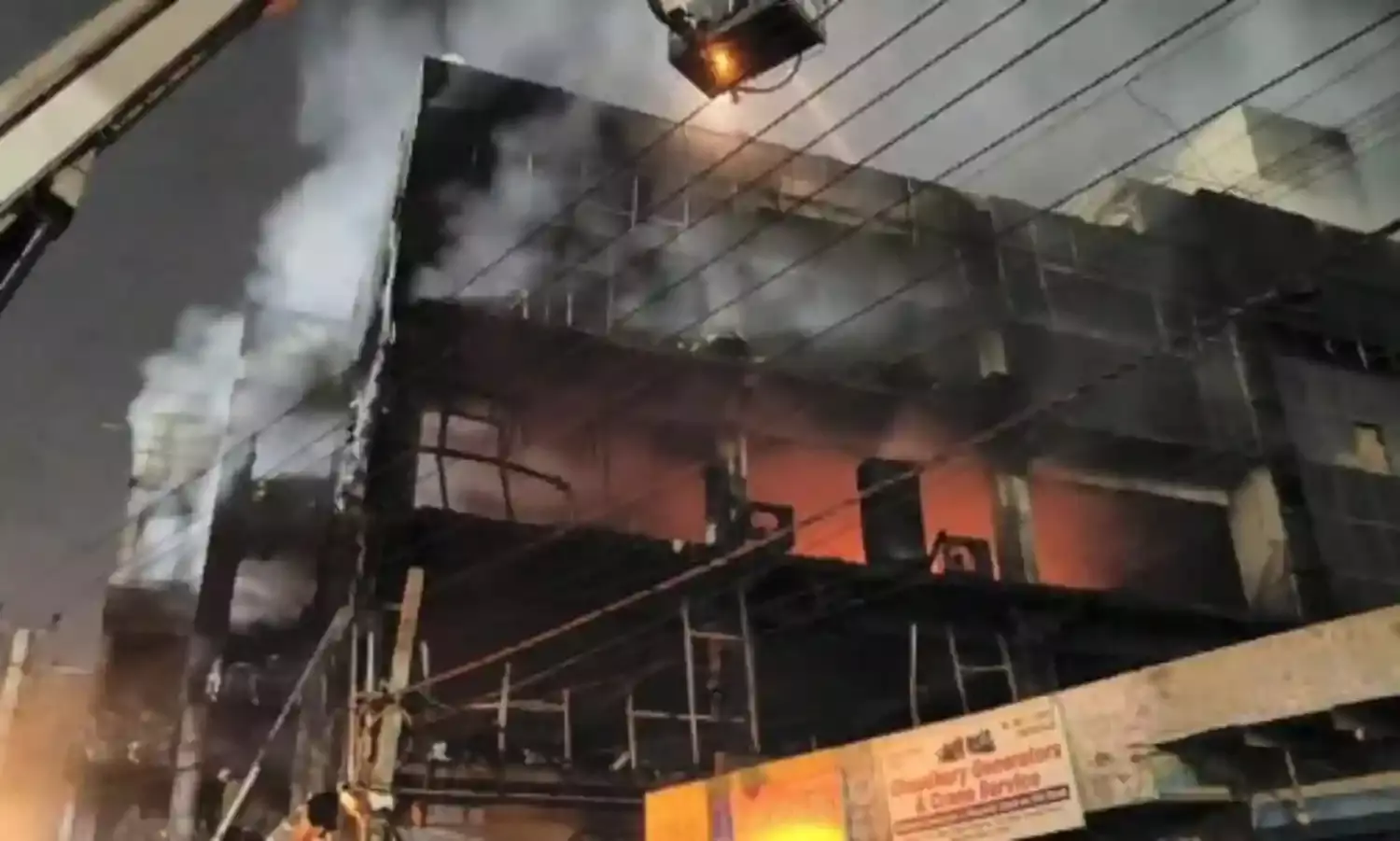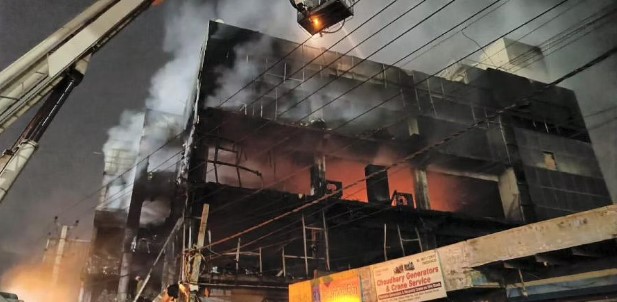‘A Disaster Management Nightmare on Many Fronts’
No objection

Within days of the fire in a four storey commercial building in Mundka on May 13, the building owners and the tenant business owner absconding were apprehended by police. At least 27 people died in the fire that injured 17, and survivors say the figures are an undercount.
Now nearly two weeks later, the families of the deceased are still waiting to be handed over their loved ones’ remains. West Delhi deputy commissioner of police Sameer Sharma reportedly said that the results of forensic tests to identify the remains are expected next week.
According to Atul Garg, director of the Delhi Fire Service, the Mundka fire “occurred because of the total negligence of the owners and the building authority. There were more than 200 persons working there, there was only a single staircase, that too it was overloaded with (electronic and plastic) materials.”
The building was four storeys tall, with far more people working there than it could safely shelter. A business assembling CCTV cameras, routers and other electronic products was operating out of the building, said Garg.
It had only one staircase and no fire safety equipment. “It depends on what work is going to go on there, but the main requirements in all buildings is the compartmentalisation, construction of two staircases of a required width, water tanks, pumps, hoses, detection system. Any building should have these provisions. This particular building had none of that.”
The owners did not have a no-objection certificate from any fire department official, required for any business establishment to obtain a licence. “A fire NOC is required for all buildings in all places, irrespective of area. Residential buildings don’t require NOC but all commercial buildings do… They never applied for an NOC.”
Garg said the lack of safety equipment was compounded by the delay in calling the fire brigade. “Even if you provide a fire extinguisher it would not have done anything to douse a fire of that size… This fire has taken such a big shape because they have passed information very late to the fire brigade. Eyewitnesses were telling that the fire started around 4 o’clock, and we got the first call about the fire at 4.40 on May 13. That is the reason when we reached there, the fire was already very high.”
After the fire, police arrested the tenant who was running the business and also the building owner, said Garg. Reports say two brothers owned Cofe Impex Pvt Ltd, the CCTV manufacturer, and that police have filed charges including culpable homicide and criminal conspiracy against them and building owner Manish Lakra.
Delhi Chief Minister Arvind Kejriwal visited the site and ordered a magisterial inquiry into the incident. He also announced Rs 10 lakh ex gratia for the kin of those who died and Rs 50,000 for the injured.
Factory workers led a protest march last week demanding the resignation of the labour minister, and said the state and central government were protecting business owners and endangering workers by issuing licences to operate without NOCs.
According to Madhav Raman, principal architect at Anagram Architects in New Delhi, “By virtue of the fact that it was in the Laldora area, they are not expected to submit drawings or plans. As far as the construction of a building is concerned you are not required to get drawings sanctioned here.”
The Delhi Master Plan of 2021 says that constructions in these areas are supposed to be residential. “But, you are allowed to undertake some level of industrial activity. It’s called ‘household industry.’” The rules for household industry constructions include limits on the number of workers and the amount of power being used. “Not more than five people can be a part of the production unit. They are not supposed to consume more than 5 kilowatts of energy.”
“If you look at the industrial activities that are allowed on village lands, this assembly of electronics is not within the ambit of things that are restricted. But it has to adhere to certain occupancy requirements, which is where the problem is… They are not illegal in their activities, but in their occupancy of the building. They had violated the regulations.”
Raman added that this was an openly commercial establishment, and not only the building owners but the fire department and municipal corporation should also be held responsible.
“They should have gone into the building and inspected it, to see the storage and godowning facilities… The point is, you can only issue NOC if someone comes to you asking for NOC… It’s the requirement of the junior engineer or the engineer in charge of that area to keep an eye out.”
The MCD and fire services should have foreseen the danger. “These guys should have gone around, they should have sealed properties regularly, they should have levied penalties on such establishments… If the building has been around for fifteen years, how has it escaped their scrutiny so far?”
“There has been criminal negligence on the part of the MCD engineers, who are supposed to monitor activities in these buildings. They are not only supposed to enforce the Master Plan and byelaws, they are supposed to regulate it in operation. The fire officer is also supposed to inspect buildings ideally.”
At the protest march on May 20 factory worker Suhana Khatoon told The Citizen, “The government officials take their commission and their bribe… The government is responsible. Had their safety been ensured, their names entered in all the documents, there wouldn’t be this distress today… There wouldn’t be any need for this if they had fulfilled their responsibility. But they don’t care. They’re apathetic. We are the ones who are dying.”
Raman described the commercial pressure. “A bulk of Delhiites suffer from the fact that we are a 2 crore strong city and we have demands for products like CCTV and industrial goods. The Master Plan has got no clue as to how it’s going to generate the industrial area where it is required… If they go to some industrial estate in the periphery, then overheads will shoot up, right? There is a power dynamic that does not work in the favour of these occupants.”
He recalled the deaths of two people in Gurgaon in February when seven storeys of a building in the Chintel Paradiso Society collapsed. A structural audit was ordered and found some 80 unsafe buildings in the area. “There was an arrest warrant against the owner of Chintel, but they also found that there is an NBCC building which was also condemned, as in it was not safe for occupancy… They did not arrest the managing director.”
He said a meet and greet was conducted between the National Buildings Construction Corporation MD and the local residents’ welfare association. “My point is when a mishap happens, the criminal liability is shifted to the owners… The building has stood fifteen years, and to claim that the liability is entirely the owners’ is very unfair.”
One of the first responders on the scene of the fire in Mundka was Sarabjeet Singh, an assistant divisional officer with the Delhi Fire Services. He confirmed the fire started around 4 pm, while the first call to the control room was at 4.40.
“As soon as the department got the call, four fire trucks were deployed to the area. But then at the same time we started getting many more calls, saying that the fire had spread and grown, and that people were trapped. And that was when Control sent more trucks to the scene of the accident.”
“This incident was declared a ‘serious call’, and for these situations many trucks are deployed, almost 25 and sometimes more… Since it was on the main road, the public gathered and the trucks arriving there had created a blockage on the street.”
“When we arrived at the scene the fire had already spread a great deal, the call had come in fairly late… The human body cannot resist heat or smoke for too long, so those who were trapped must have started feeling the effects within the first five minutes.”
“Other than in the case of a petroleum fire, any other fires take about 15-20 minutes to grow in severity… But in this case people were trapped inside, and I cannot figure why. It was quite strange.”
He thinks there would have been far less hurt had the fire services been alerted a little earlier. “In any fire incident, if we get a timely call and the fire truck can reach the location immediately, then we can work well and the casualties can be minimised by a lot. This is a bit of an issue.”
Said Raman, “If there has to be a larger understanding as to what has caused the loss of life, eventually it starts from the fact that this stepmotherly treatment is given to urban villages rather than regularising them.”
“Delhi is a disaster management nightmare on many fronts. Fire is the most apparent and most shocking… There’ll be so many fires that happen that don’t get reported or are reported in a very minor way. It is only when there is a loss of life, then immediately there are criminal issues involved.”




